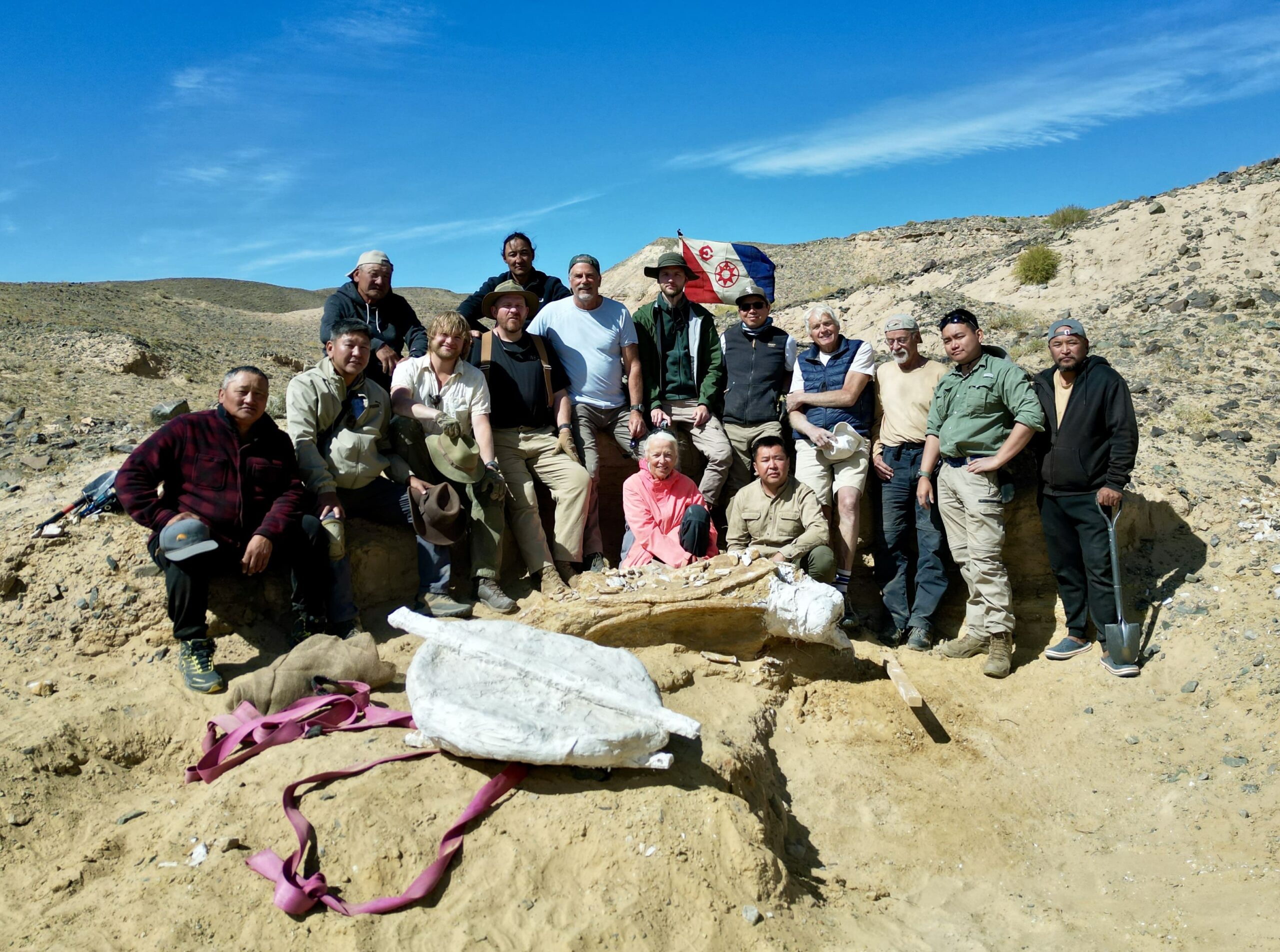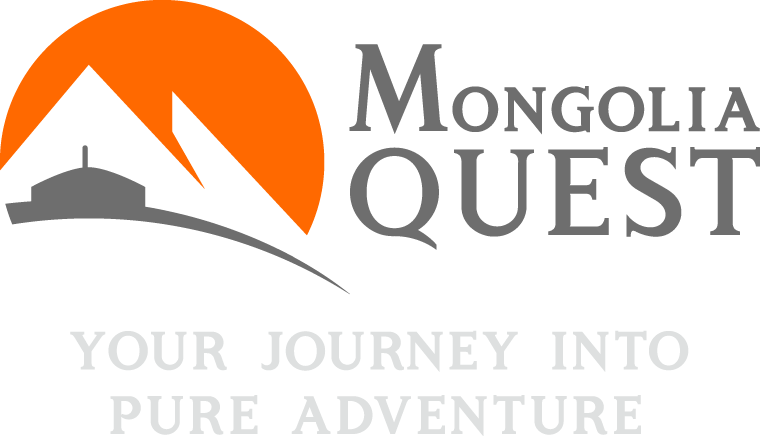Under the Mongolian Learning Academy Project, we’re creating meaningful travel experiences across archaeology, history, anthropology, art, culture, wildlife, and paleontology. This is the story of our journey to building a citizen science initiative through paleontological expeditions in the vast Gobi Desert.

How It Started
Mongolia Quest began with a vision shared by founders Mr. Gereltuv and Mr. Badral: to create a new kind of tourism that blends science, education, cultural discovery, adventure, and sustainability, while supporting herders, scholars, conservationists, and community leaders.
In September 2022, we welcomed back renowned vertebrate paleontologist Dr. Phil Currie (University of Alberta, Canada) to lead the annual Dinosaurs of Mongolia expedition. During this trip, a scientific plan was developed for 2023, aiming to uncover the missing bones of Nemegtosaurus at the historic site where its holotype was first collected during the Polish-Mongolian Paleontological Expeditions of 1965.
Historically, the 1965 expeditions uncovered two sauropods in the Nemegt Formation: a skull without a skeleton, named Nemegtosaurus mongoliensis, and a skeleton without a skull, named Opisthocoelicaudia skarzynskii. Later research revealed that both were titanosaurid sauropods, but confirming this required finding overlapping bones.
The 2023 expedition, conducted by a multinational team of ten paleontologists in partnership with the Institute of Paleontology, Mongolia, focused on excavating the Nemegtosaurus quarry in the Nemegt Basin, one of the world’s most important Late Cretaceous fossil sites. Over 20 days of fieldwork, the team uncovered numerous important fossil remains.
This expedition also demonstrated the potential of responsible tourism, showing how travelers can directly contribute to scientific research. Thanks to the generous support of Mr. Graham Taylor and Mr. Clint Coker from Australia, the expedition became a reality — a true example of how science, adventure, and community engagement can come together.
Citizen Science in Action
With over 30 years of experience in educational travel, our team has learned that research papers alone rarely inspire broad public engagement or policy change. By bringing citizens into the field alongside professional scientists, we offer hands-on experiences that allow participants to:
- Excavate fossilized bones and document field finds.
- Operate tools like portable XRF devices to analyze geochemical signatures of fossils and surrounding sediments.
- Contribute to mapping fossil sites and cataloging specimens.
These immersive experiences turn participants into ambassadors for paleontology, fostering curiosity, conservation awareness, and even nurturing future paleontologists. Many participants report lifelong inspiration and a deeper connection to science.
Expanding the Vision
Since 2023, the Dinosaurs of Mongolia expedition has been held annually, co-led by renowned paleontologist Dr. Phil Currie and paleobotanist Dr. Eva Koppelhus.

2025 Lost Dinosaurs of the Gobi expedition.
In 2024 and 2025, our collaborations expanded to include Dr. Phil Bell and Dr. Nic Campione from the University of New England (Australia), launching the annual Lost Dinosaurs of the Gobi Desert expedition. This program is designed to:
- Assist paleontologists in discovering and documenting new dinosaur fossils.
- Support global efforts to combat the illegal fossil trade.
- Engage participants in authentic scientific research, including geochemical fingerprinting of fossils to trace poached specimens.
During 2024–2025, we also strengthened our partnership with New Scientist Magazine (UK) to organize the annual Cretaceous Dinosaurs in Mongolia program.
The continued support of the Institute of Paleontology, Mongolia, remains essential—providing excavation permits, scientific expertise, and on-site guidance for all expeditions.
Scientific Achievements
Over the past four years and eight consecutive paleontological expeditions, our collaborations have already produced significant scientific contributions.
All fossils uncovered are meticulously cataloged and transferred to the Institute of Paleontology of Mongolia, ensuring proper preservation and study. Notable publications from our expeditions include:
- Currie, P. J. (2023). Celebrating dinosaurs: their behaviour, evolution, growth, and physiology. Canadian Journal of Earth Sciences. Read here
- Bell, P. R., Woodruff, D. C., Nguyen, K., Mainbayar, B., & Currie, P. J. (2025). Remarkable soft tissue anatomy recorded in titanosaur (Sauropoda) tracks from the latest Cretaceous of Mongolia. Zoological Journal of the Linnean Society. Read here
What’s Next?
Mongolia is home to some of the richest dinosaur fossil sites in the world, and at a time when roughly 30 new dinosaur species are described globally each year, we are committed to ensuring the country remains a key contributor to paleontological research.
As a leader in educational tourism and citizen science, we continue to:
- Raise funds and increase public awareness.
- Support Mongolian and international scientists in their research.
- Inspire and prepare the next generation of paleontologists through hands-on fieldwork and immersive expeditions.
By collaborating closely with scientists, local herder communities, and research institutions, we create opportunities for travelers to actively contribute to Mongolia’s scientific legacy while gaining a deeper understanding of its global significance.
Brief Updates of 2025
We are proud to share that our CEO, Gereltuv Dashdoorov, has officially become a member of the prestigious Explorers Club, marking Mongolia Quest as the first expedition-focused, field-based scientific travel organization from Mongolia to join this historic community.

During the Dinosaurs of Mongolia 2025 expedition, the team uncovered multiple articulated fish skeletons. This provides rare evidence of scavenging behavior and offers valuable insight into fish diversity in the Nemegt Basin.

The Lost Dinosaurs of Mongolia 2025 expedition unearthed well-preserved and possibly complete juvenile Tarbosaurus skeleton which will be fully excavated next year.
A Gallimimus skeleton (not poached) was also discovered and uncovered. It appears that the skull had been destroyed by erosion before the specimen was found. The fossil was carefully capped with plaster and burlap, and will be collected in 2026.
At Tögrögiin Shiree, a Protoceratops skull was found by the Cretaceous Dinosaurs of Mongolia 2025 expedition. The team plans to return to the site in 2026 to retrieve the remaining skeleton, which appears to be in an upright position.
We thank all our team members, partners, and travelers for making this milestone possible. We invite all curious travelers and science enthusiasts to join us in this exciting continuation



